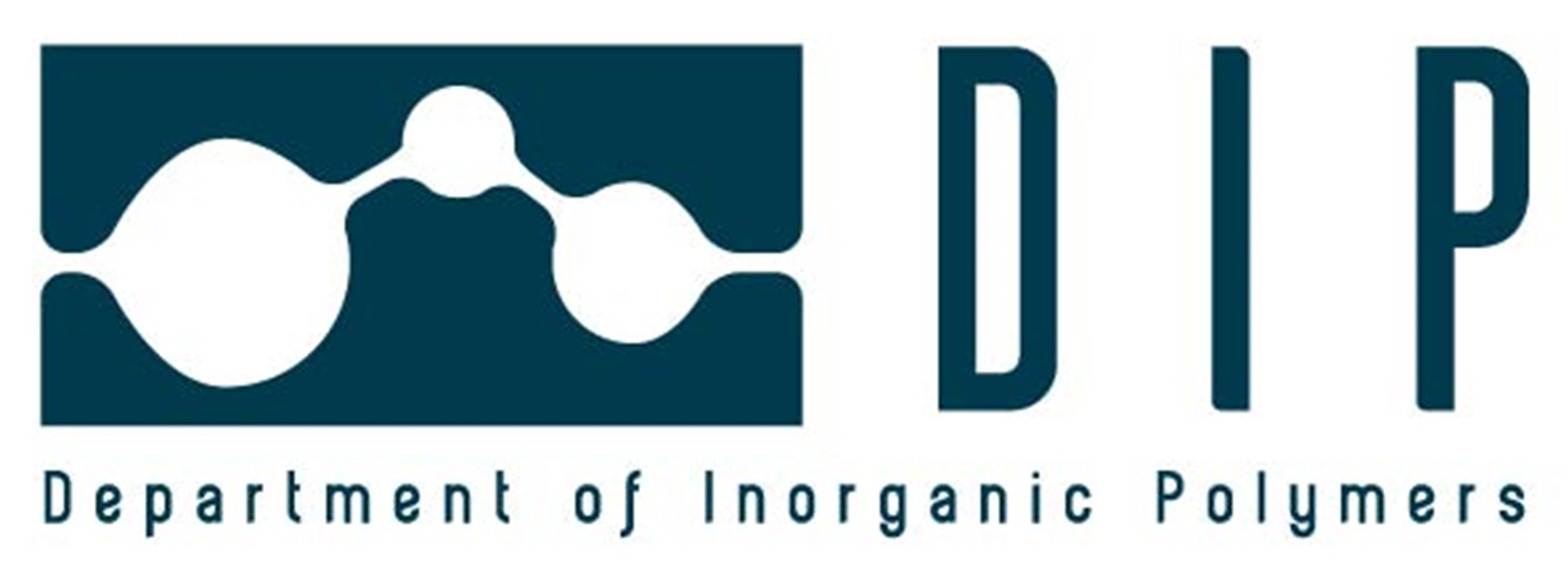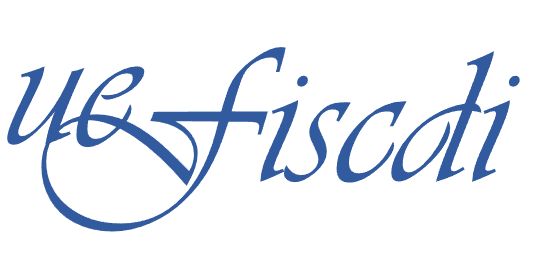Estimated results
Knowledge in the field of 2D materials, more specifically in the field of two-dimensional metal-organic coordination networks (2D MON); obtaining protocols; creation of a suitable ligand library; creation of a library of permethylated 2D metal-organic networks; publication of scientific articles and presentations at conferences.
Partial results - 2021
Stage 1 (2021)
Activities provided
Activity 1.1. Synthesis of ligands with nitrogen-containing donor groups and structural characterization.
Activity 1.2. Synthesis of carboxylic ligands, purification and structural characterization.
Activity 1.3. Preliminary complexation tests to evaluate the suitability of the ligands for the purpose of the project (formation of two-dimensional metal-organic coordination networks, 2D MON).
Activity 1.4. Dissemination: publication, presentations at scientific events, popularization
Expected results:
- Six well characterized ligands – achieved: 14
- Three presentations at conferences – achieved: 4
- Two articles submitted for publication – achieved: 8 (5 published in ISI rated journals and 3 published in volumes of scientific events)
- Project web page
- Scientific report
- Published articles: 5 in ISI journals (CIF: 23,262) and 3 in online proceedings
- M. Cazacu, C. Racles, M.F. Zaltariov, M. Dascalu, A. Bele, C. Tugui, A. Bargan, G. Stiubianu, From amorphous silicones to Si-containing highly ordered polymers: Some romanian contributions in the field. Polymers, 2021, 13, 1605. https://doi.org/10.3390/polym13101605 F.I.=4.329, Q1
- M. Damoc, A.C. Stoica, M. Dascalu, M. Asandulesa, S. Shova, M. Cazacu, Dual crystalline-amorphous salen-metal complexes behave like nematic droplets with AIEgens vistas, Dalton Transactions, 2021, 50, 13841. https://doi.org/10.1039/D1DT01980E F.I.=4.390, Q1
- A.C. Stoica, M. Damoc, M.F. Zaltariov, C. Racles, M. Cazacu, Two-dimensional coordination polymers containing permethylated motifs - promising candidates for 2D emerging materials. Structural, behavioral and functional particularities, Reactive and Functional Polymers, 2021, 168, 105039. https://doi.org/10.1016/j.reactfunctpolym.2021.105039 F.I.=3.975, Q2
- A. Arauzo, E. Bartolomé, J. Luzón, P.J. Alonso, A. Vlad, M. Cazacu, M.F. Zaltariov, S. Shova, J. Bartolomé, C. Turta, Slow magnetic relaxation in {[CoCxAPy)] 2.15 H2O}n MOF built from ladder-structured 2D layers with dimeric SMM rungs, Molecules, 2021, 26, 5626. https://doi.org/10.3390/molecules26185626 I.F.=4.411, Q1
- A.C. Stoica, M. Damoc, V. Tiron, M. Dascalu, A. Coroaba, S. Shova, M. Cazacu, Silanol-functionalized tetranuclear copper complex and its nanoscale-heterogenization by immobilization on glass surface from solution, Journal of Molecular Liquids,2021, 344, 117742. https://doi.org/10.1016/j.molliq.2021.117742 I.F.=6.165, Q1
- Articles published in volumes of scientific events: 3
- M. Damoc, A.C. Stoica, M. Dascalu, A.M. Macsim, R.I. Tigoianu, D. Blaj, A.G. Rusu, M. Iacob, M. Cazacu, Siloxane/Silane derivatives based on 5-amino-1,3,4-thidiazole-2-thiol and their gold complexes: interfacial phenomena based on photoluminescence, International Conference Progress in Organic and Macromolecular Compounds 28th Edition, Macro Iasi 2021, Iasi, Romania, October 7 - 9, 2021, Proceedings (Online) ISSN 2810 - 2347 ISSN - L 2810 - 2126
- M. Damoc, A.C. Stoica, D. Blaj, A.M. Macsim, M. Dascalu, M. Cazacu, Multi-step procedure leading to heterocycle containing dimethylsilane unit, Scientific communications of young researchers, MacroYouth'2021, 2nd Edition, Iasi, November 19, 2021, Proceedings (Online)
- A.C. Stoica, M. Damoc, M. Dascalu, M. Cazacu, Copper tetranuclear complex bearing silanol functional groups, Scientific communications of young researchers, MacroYouth'2021, 2nd Edition, Iasi, November 19, 2021, Proceedings (Online)
- Presentations at scientific events: 4
- A.C. Stoica, M. Damoc, G.T. Stiubianu, M. Cazacu, Permethylated two-dimensional Metal-Organic Frameworks - promising candidates for emerging 2D materials, International Conference on Advances in Functional Materials, UCLA (AAAFM-UCLA)-oral presentation online
- M. Damoc, A.C. Stoica, M. Dascalu, A.M. Macsim, R.I. Tigoianu, D. Blaj, A.G. Rusu, M. Iacob, M. Cazacu, Siloxane/Silane derivatives based on 5-amino-1,3,4-thidiazole-2-thiol and their gold complexes: interfacial phenomena based on photoluminescence, International Conference Progress in Organic and Macromolecular Compounds 28th Edition, Macro Iasi 2021, Iasi, Romania, October 7 - 9, 2021 - oral presentation, Best Oral Presentation for MSc/PhD/postdoc students (awarded by Romanian International Chapter of ACS).
- M. Damoc, A.C. Stoica, D. Blaj, A.M. Macsim, M. Dascalu, M. Cazacu, Multi-step procedure leading to heterocycle containing dimethylsilane unit, Scientific communications of young researchers, MacroYouth'2021, 2nd Edition, Iasi, November 19, 2021- oral presentation online
- A.C. Stoica, M. Damoc, M. Dascalu, M. Cazacu, Copper tetranuclear complex bearing silanol functional groups, Scientific communications of young researchers, MacroYouth'2021, 2nd Edition, Iasi, November 19, 2021- oral presentation online


Summary of stage 1
In this stage of the project, 14 ligands containing dimethylsilane or tetramethyldisiloxane units as spacers or attached trimethylsilane units were prepared. The role of these fragments, which are known to be highly hydrophobic, is to confer an amphiphilic character to the formed ligands of interest for the next stage of the project. For the synthesis of ligands, chloroalkylated silicone derivatives were generally used as precursors, namely chloropropyltrimethylsilane, chloromethyltrimethylsilane, bis(chloromethyl)dimethylsilane, bis(chloromethyl)tetramethyldisiloxane and 1,3-bis(3-aminopropyl)tetramethyldisiloxane. For their derivatization, thiol substitution reactions with chloroalkylated silicone derivatives, Huisgen 1,3-dipolar cycloaddition, Hofmann carbylamine reaction and imine condensation reaction were used. All ligands were characterized by spectral methods (IR, NMR), most of them by elemental analysis, UV-Vis spectrophotometry and fluorescence and single crystal X-ray diffraction and in some cases by ESI-MS. Different protocols were tested (ligand/co-ligand mixtures, single ligand, heating under normal conditions, solvothermal) for obtaining 2D coordination networks with dicarboxylic ligands containing dimethylsilane and tetramethyldisiloxane spacers. The structures formed were determined by single crystal X-ray diffraction. The activities carried out and the compounds obtained in this stage of the project constitute the basis for the implementation of the next stage of the project. The scientific results were disseminated in five scientific articles published in ISI journals, and four oral presentations at scientific events. Three short articles were published in volumes of these manifestations.
Partial results - 2022
Stage 2 (2022)
Activities provided
Activity 2.1. Synthesis of 2D metal-organic coordination networks consisting of 1D self-assembled structures in 2D layers through intermolecular physical interactions. Structural characterization and evaluation of some properties.
Activity 2.2. Synthesis of 2D mass-covalent metal-organic coordination networks based on a mixture of ligands (carboxylic and N-donors). Structural characterization and evaluation of some properties.
Activity 2.3. Delamination by a "top-bottom" approach of stacked 2D networks: establishing the work protocol, evaluating the degree of disaggregation and the quality of the nanosheets.
Activity 2.4. Preparation of composites based on delaminated MON 2D nanosheets and PDMS, processing as films and cross-linking.
Activity 2.5. Dissemination: publication, presentations at scientific events, popularization
Verifiable estimated results of the activity/achieved
- Four new metal-organic coordination networks (MONs) characterized in mass and registered in the database – achieved: 10; recorded: 6
- A protocol for "top-down" delamination – achieved: 1
- Three presentations at conferences – achieved: 6
- Two articles submitted for publication – achieved: 5
- Project web page
- Scientific report
- Published articles: 5 in ISI journals (CIF: 21.355)
- V.M. Hiiuk, S.I. Shylin, D.D. Barakhtii, D.M. Korytko, V.O. Kotsyubynsky, A. Rotaru, S. Shova, I.A. Guralskiy, Two-Step Spin Crossover in Hofmann-Type Coordination Polymers [Fe(2-phenylpyrazine)2{M(CN)2}2] (M = Ag, Au), Inorganic Chemistry 2022, 61, 4, 2093-2104, https://doi.org/10.1021/acs.inorgchem.1c03302, I.F.=5.436
- R.I. Gurtovyi, S.P. Gavrish, L.V. Tsymbal, M.-O. Apostu, M. Cazacu, S. Shova, Y. D. Lampeka, 2D coordination polymers and ionic complexes of the nickel(II) and zinc(II) cyclam cations with trigonal carboxylate linkers based on triazine core. Crystal structures, supramolecular catenation and spectral characterization, Polyhedron 221 (2022) 115870, https://doi.org/10.1016/j.poly.2022.115870, I.F.=2.975.
- M. Damoc, A.-C. Stoica, D.-A. Blaj, A.-M. Macsim, M. Dascalu, C. Cojocaru, S. Shova, M. Cazacu, Fourteen-member silacycle built by cascade reactions induced by a platinum catalyst, Journal of Molecular Structure, 1269, 2022, 133760, 0022-2860, https://doi.org/10.1016/j.molstruc.2022.133760, I.F.=3.841.
- A.-C. Stoica, M. Damoc, C. Cojocaru, A. Nicolescu, S. Shova, M. Dascalu and M. Cazacu, Some theoretical and experimental evidence for particularities of the siloxane bond, Molecules 2022, 27, 23, https://doi.org/10.3390/molecules27238563, I.F.=4.927.
- M. Damoc, R.I. Tigoianu, A.-C. Stoica, A.-M. Macsim, M. Dascalu, S. Shova, M. Cazacu), Micellization Turned on Dual Fluorescence and Room Temperature Phosphorescence by Pseudo-ESIPT in Thiadiazole Derivatives, Journal of Physical Chemistry C, jp-2022-064557, acceptata I.F.=4.177.
- Articles published in volumes of scientific events: 1
- M. Damoc, A.-C. Stoica, M. Cazacu, Merging hydrophobic moieties within five-membered heterocycles. Mighty approaches toward achieving some spectacular phenomena, Scientific communications of young researchers, MacroYouth'2022, 3th Edition, Iasi, November 18, Proceedings, 11-12.
- Presentations at scientific events: 6
- M.-F. Zaltariov, Metal-organic framework (MOFs) - alternative routes in conservation of cultural heritage, Conferinta stiintifica internationala "Patrimoniul cultural de ieri - implicatii in dezvoltarea societatii durabile de maine" editia a V-a - 22 februarie 2022, Chisinau, oral presentation
- M.-F. Zaltariov, M. Avadanei, C.-D. Varganici, I. Spiridon, Silicone materials embedding lanthanum complexes. The behavior in artificial weathering conditions, Cultural heritage of yesterday - Contribution to the development of a sustainable society of tomorrow, the VIth Edition, Iasi-Chisinau, 27 - 28 September 2022, oral presentation
- M. Damoc, R.I. Tigoianu, A.-C. Stoica, A.-M. Macsim, M. Dascalu, S. Shova, M. Cazacu, Efficient light harvesting strategies by suppressing the kasha 's rule in thiadiazole derivatives, A XXXVI-a Conferinta Nationala de Chimie, Calimanesti-Caciulata, 4-7 octombrie 2022, oral presentation
- A.-C. Stoica, M. Damoc, M. Dascalu, M. Cazacu, Coordination polymers built with 1,3-bis(cyanopropyl)tetramethyldisiloxane ligand, A XXXVI-a Conferinta Nationala de Chimie, Calimanesti-Caciulata, 4-7 octombrie 2022, oral presentation
- A.C. Stoica, M. Damoc, M. Dascalu, M. Cazacu, Particularitati in comportarea chimica a 1,3-bis(2-minoetilaminometil)tetrametildisiloxanului, Sesiunea de Comunicari Stiintifice a Studentilor, Masteranzilor si Doctoranzilor, "Chimia-frontiera deschisa spre cunoastere", Editia a XIII-a, Iasi, 28 octombrie 2022, oral presentation
- M. Damoc, A.-C. Stoica, M. Cazacu, Merging hydrophobic moieties within five-membered heterocycles. Mighty approaches toward achieving some spectacular phenomena, Scientific communications of young researchers, MacroYouth'2022, 3th Edition, Iasi, November 18, 2022, oral presentation
Summary of stage 2
Based on the experimental program, developed at the beginning of the project implementation, and the activity schedule, in this stage, a series of coordination polymers with ligands containing siloxane or silane spacers were prepared. Depending on the reactants used and the reaction conditions, structures with dimensions from 1D to 3D were obtained. Taking into account the purpose and the proposed objectives, 10 2D structures were selected for the report of this stage, of which five formed by the supramolecular self-assembly of covalent 1D structures and five are covalent 2D structures as results of activities A2.1 and A2.2 of the project. The obtained compounds were structurally characterized by elemental, spectral and crystallographic analysis and for some of them, depending on the structure, properties of interest were evaluated (sorption and stability to humidity, porosity, behavior and thermal stability, magnetic properties or optics). Despite the premises created by the "bottom-up" approach by using a ligand with surface activity, the obtained 2D coordination networks are still stacked in fairly large blocks, of the order of hundreds of micrometers, even if the cohesive forces are low, as indicate crystallographic studies. As a result, an additional "top-down" procedure was identified and applied, consisting in the ultrasonication of the crystalline compound dispersed in liquids with low to medium polarity, such as THF, this being the result of activity A2.3 of the project. 2D compounds were used as fillers for the silicone matrix in order to give it specific, active functionalities. The presence in the structure of methylsilicone segments, similar to the matrix, creates the conditions for a good compatibility. Two incorporation procedures were applied, (i) from the solution when, due to the amphiphilic character, the complex micelles in the matrix remaining in the form of spherical aggregates after solvent removal, and (ii) from the dispersion of the metallic complex, when the nanosheet structure of the 2D network crystalline remains, being able to give the resulting composite the specific properties due to this two-dimensional characteristic. As a result of activity A2.4, a series of 17 composites was prepared, whose characterization is foreseen for the next stage of the project. Within the A2.5 activity, the scientific results were disseminated in five scientific articles published in ISI journals (CIF: 21.355), a short article in the volume of a scientific event and six oral presentations at scientific events.

The asymmetric unit (a), 1D structure and supramolecular interactions in the crystal structure (b) of the zinc linear polymer with a siloxane spacer ligand (CCDC 2223045)

The asymmetric unit (a), 2D structure (b) and supramolecular interactions in the crystal structure (c) of the cobalt 2D polymer with siloxane spacer ligand (CCDC 2223043)

Structural unit (a) and crystal packing with the formation of a dense 2D structure (b) of lead complex with silane spacer (CCDC: 2223663)
Results - 2023
Stage 3 (2023)
Activities provided
Activity 3.1. Attempts to obtain MON nanosheets by complexation at the interface and by diffusion.
Activity 3.2. Deposition of 2D layers through layer by layer and LB techniques or other approaches.
Activity 3.3. Analysis of free-standing MON nanosheets and on the substrate obtained by the "bottom-up" approach: structure, morphology, properties and performance comparison with those of bulk counterparts.
Activity 3.4. Evaluation of the applicative potential of MON nanosheets for the detection of gases and solvent vapors and the response to UV or laser irradiation (when applicable).
Activity 3.5. Incorporation of 2D MON nanosheets as active additives in soft silicone matrices (PDMS) to obtain advanced composites, characterization of the resulting materials and evaluation of properties.
Activity 3.6. Dissemination: publications, presentations at scientific events, promotion.
Estimated/achieved verifiable results:
- Two optimized layer deposition protocols – achieved: 3
- Two product sheets – achieved: 2
- Two test reports – achieved: 2
- A well characterized composite – achieved: 2
- Four presentations at scientific events – achieved: 6
- A completed PhD thesis – achieved: 2
- Updated web page – achieved
- Scientific report
- Published articles: 3 in ISI journals (CIF: 19.9)
- A.-C.Stoica, M. Damoc, S. Shova, G. Novitchi, M. Dascalu, M. Cazacu, Manganese(II) 3D Metal-Organic Framework with Siloxane-Spaced Dicarboxylic Ligand: Synthesis, Structure, and Properties, Inorganics 2023, 11, 21, https://doi.org/10.3390/inorganics11010021, FI : 2,9; Q2
- M. Damoc, R.I. Tigoianu, A.C. Stoica, A.M. Macsim, M. Dascalu, S. Shova, M. Cazacu, Micellization Turned on Dual Fluorescence and Room Temperature Phosphorescence by Pseudo-ESIPT in Thiadiazole Derivatives, The Journal of Physical Chemistry C 2023, 127 (1), 99-109,https://doi.org/10.1021/acs.jpcc.2c07651, FI : 3,7; Q2
- M. Damoc, V. Tiron, C. Tugui, C.D. Varganici, A.C. Stoica, G. Novitchi, M. Dascalu, M. Cazacu, Ferronematic Co(II) Complex: An Active Filler for Magnetically Actuated Soft Materials, Small 2023, 2307006,https://doi.org/10.1002/smll.202307006, FI : 13,3; Q1
- Articles published in volumes of scientific events
- Zaltariov, M.-F.; Shova, S.; Cazacu, M., S-block coordination polymers built up with silicon-containing carboxylate linkers, Progress in Organic and Macromolecular Compounds - Proceedings, ISSN 2810 - 2126 | ISSN-L 2810 - 2126; ISSN 2810 - 2347 (Online version) https://icmpp.ro/macroiasi2023/proceedings.php, pp.71-73
- Stoica, A.C.; Dascalu, M.; Damoc, M.; Cazacu, M., Some coordination polymers with pyridine-based ligands: synthesis and structural characterization, Progress in Organic and Macromolecular Compounds - Proceedings, ISSN 2810 - 2126 | ISSN-L 2810 - 2126; ISSN 2810 - 2347 (Online version), https://icmpp.ro/macroiasi2023/proceedings.php, pp.135-137
- Book chapters
- Zaltariov, M.F., Metal-Organic Frameworks: Emerging Porous Materials for Energy Applications, Chapter 3 in Advances In Energy Materials- New Composites and Techniques for Future Energy Applications, Eds. I. Stoica, A.R. Abraham, A.K. Haghi, Apple Academic Press, pp. 47-77 (2024). Published October 27, 2023 by Apple Academic Press
- Presentations at scientific events
- Mirela-Fernanda Zaltariov, Sergiu Shova, Maria Cazacu, S-block coordination polymers built up with silicon-containing carboxylate linkers, Progress in Organic and Macromolecular Compounds 29th Edition, Iasi, Romania, October 4 - 6, 2023 - communication
- Madalin Damoc, V. Tiron, C. Tugui, Cristian-Dragos Varganici, Alexandru-Constantin Stoica, Ghenadie Novitchi, Mihaela Dascalu, Maria Cazacu, A ferronemtic Co(II) coordination compound suitable as active filler for magnetically actuated materials, Madalin Damoc, Vasile Tiron, Codrin Tugui, Progress in Organic and Macromolecular Compounds 29th Edition, Iasi, Romania, October 4 - 6, 2023 - communication Best Oral Presentation
- Mirela-Fernanda Zaltariov, Silicon-based Metal-Organic Frameworks for Biomedical Applications: Opportunities and Challenges, The international scientific conference "Cultural heritage of yesterday - implications for the development of tomorrow's sustainable society" 7th edition. The scientific event held in the context of the International Day of Girls and Women with Activities in the Field of Science February 9-10, 2023, Chisinau - conferinta online
- Alexandru-Constantin Stoica, Mihaela Dascalu, Madalin Damoc, Maria Cazacu, Some coordination polymers with pyridine-based ligands: synthesis and structural Characterization, Progress in Organic and Macromolecular Compounds 29th Edition, Iasi, Romania, October 4 - 6, 2023 - poster Best Young Scientist Poster Presentation
- Damoc, M., Stoica, A.-C., Cazacu, M., Engineering Organic Heterocycles and Silacycles Through a Pt(II), Catalyst The International School on Innovations in Homogeneous and Supported Homogeneous Catalysis, 25-28 aprilie, 2023, Bucuresti, Romania - poster
- Damoc, M., Tigoianu, R.I., Stoica, A.-C., Cazacu, M., High-Energy Intermolecular Proton Transfer Generating Multiple Emissions in Aminothiadiazole Derivatives, Thematic School Vibrational and Electronic spectroscopies applied to the study of reaction mechanisms - MECAREACT, 18-23 june, 2023, Paris, France - poster
- PhD theses completed in the field of the project
- "Proligands and coordination compounds, having flexible and hydrophobic fragments, capable of self-organization", elaborated by chim. Madalin Damoc, PhD supervisor: dr. M. Cazacu, defended 18.07.2023
- "Coordination compounds of different dimensionality with ligands containing siloxane spacers", elaborated by chim. Alexandru-Constantin Stoica, PhD supervisor: dr. M. Cazacu, will be defended 12.12.2023

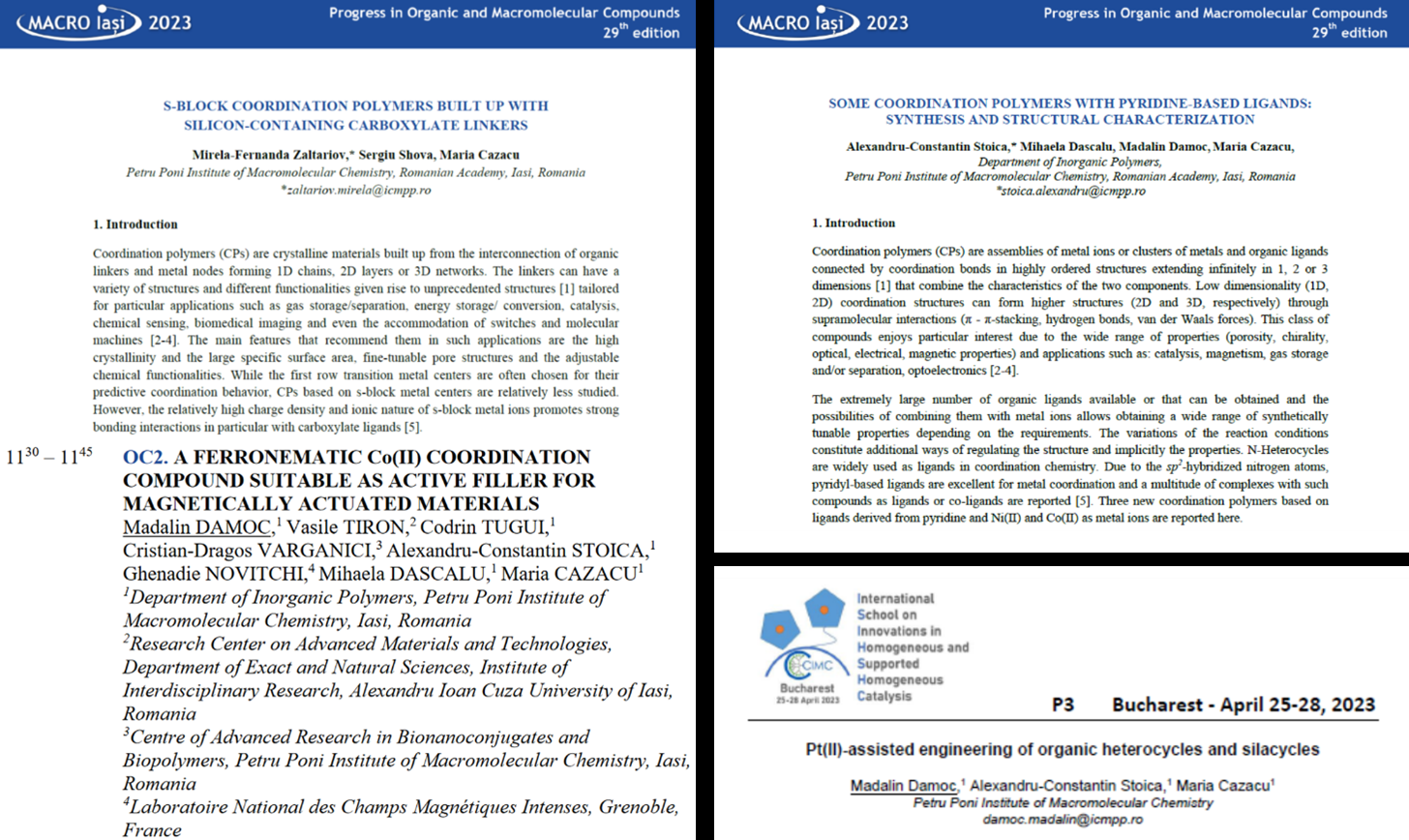
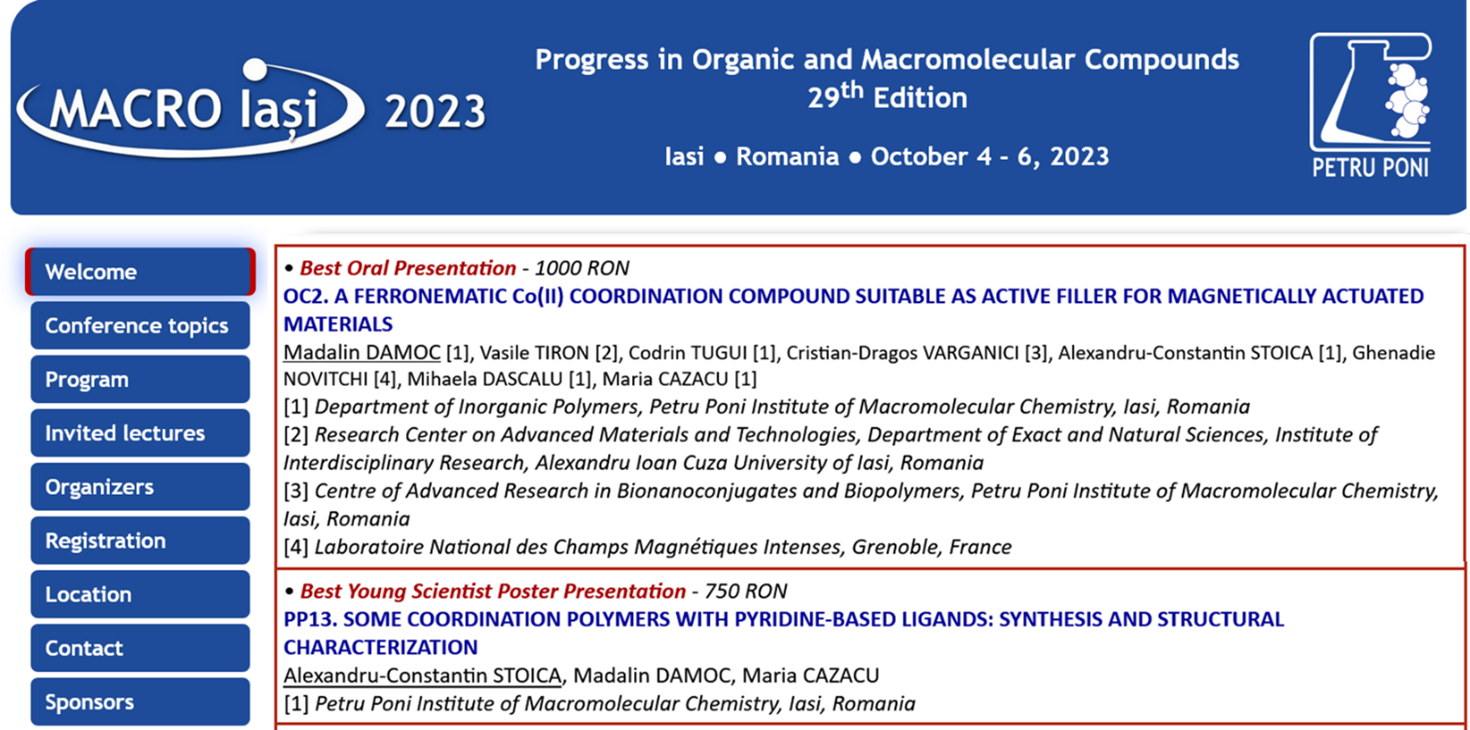
Summary of stage 3
Different procedures have been followed to obtain 2D coordination polymers in the form of nanometer-thick sheets: complexation at the interface, complexation by diffusion of reactants or precipitation of the complex already formed at the interface. In the latter case, the thickness of the sheets formed was about 17 nm, as estimated by the AFM technique (Figure 1). Also, the Langmuir-Blodgett technique was used with the equipment purchased from the project budget (Figure 2) for the deposition of three metal-ligand systems. The layers deposited on a glass substrate or silicone film by this technique were analyzed by AFM, the relevant images showing the formation of more or less uniform layers. It was found that the immersion speed of the substrate in the deposition solution has a very important role, the lower speed favoring the deposition of uniform layers (Figures 3, 4).

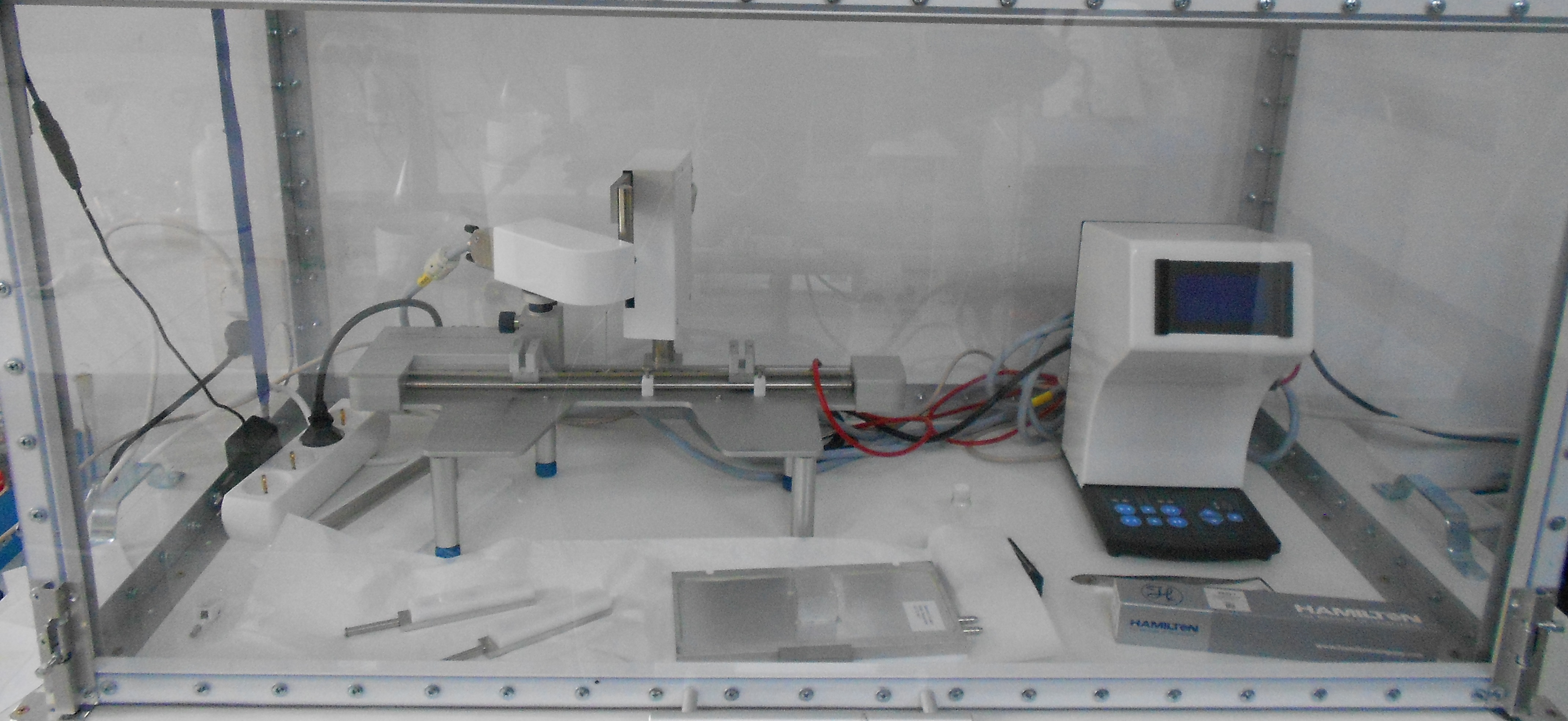


Circular crystalline nanosheets, with diameters of 20-40 µm and thicknesses of 8-10 µm, were obtained in the case of the 2D coordination polymer based on Dy coordinated with bis(carboxyphenylene)diphenylsilane, by slow evaporation of the solvent (Figure 5). Some structures were evaluated from the point of view of hydrophobicity, specific surface area and free volume accessible for gases (H2, N2 and CO2 ), magnetic and dielectric properties, photoisomerization capacity, behavior in solvent environment (Figure 6). Several coordination compounds obtained in the previous stages of the project were delaminated by ultrasound in a non-solvent and were incorporated in different percentages in a silicone matrix, obtaining composites that were processed in the form of films and stabilized by condension-crosslinking with tetraethoxysilane. Apparently uniform, colored and very flexible films were obtained. These were analyzed from the point of view of morphology by SEM, mechanical properties, stress-strain tests, and dielectric characteristics. The theoretical calculations based on the experimental values obtained for the mechanical and electrical characteristics indicate these composites as being suitable as active elements in electromechanical power generation devices. The hydrophobicity of the films, highlighted by the recording of the water vapor sorption isotherms in dynamic regime, indicates the stability of the material's characteristics in a wet environment. Another functionality highlighted for such composites is that of sensitivity to solvent vapor when it reversibly changes its color and implicitly the UV absorption spectrum (Figure 7), thus making them suitable as solvent vapor sensors. The dissemination of scientific results achieved at this stage can be found in three articles published in ISI journals, two in volumes of scientific events, a book chapter, six presentations at scientific events, two of which were awarded. Also, two PhD theses were completed.



